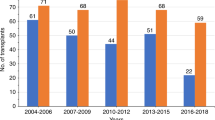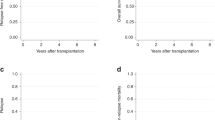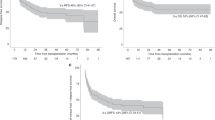Abstract
We retrospectively analyzed the outcomes of 26 patients with acute promyelocytic leukemia (APL) in the first CR (CR1) or second CR (CR2), who underwent autologous PBSCT (auto-PBSCT) between 1992 and 2008. All patients received all-trans retinoic acid-based induction therapy. After two courses of consolidation chemotherapy, upfront auto-PBSCT was performed in 20 patients in the CR1. Five patients had a high WBC count of more than 10 × 109/L (high risk), while 15 patients had a count of less than 10 × 109/L (low risk) at initial presentation. In addition, six patients, who were considered as low-risk patients at presentation, had a relapse after three cycles of consolidation and 2 years of maintenance therapy, but gained the molecular remission after re-induction and consolidation, and underwent auto-PBSCT in the CR2. In 26 recipients, engraftment was rapid and no TRM was documented. All 20 patients autotransplanted in CR1 were still in CR at a median of 133 months (73–193 months), and six patients who underwent auto-PBSCT in CR2 were also still in CR at a median of 41 months (2–187 months) without maintenance therapy. PML/RARα chimeric mRNA was undetectable in PBSC or BM samples examined before auto-PBSCT. Despite a small number of cases studied, our retrospective observations suggest that auto-PBSCT may be an effective treatment option to continue durable CR in the treatment of high-risk APL. We review previous reports and discuss the role of autotransplantation in the treatment of APL patients in CR.
This is a preview of subscription content, access via your institution
Access options
Subscribe to this journal
Receive 12 print issues and online access
$259.00 per year
only $21.58 per issue
Buy this article
- Purchase on Springer Link
- Instant access to full article PDF
Prices may be subject to local taxes which are calculated during checkout
Similar content being viewed by others
References
Sanz MA, Martin G, Gonzalez M, Leon A, Rayon C, Rivas C et al. Risk-adapted treatment of acute promyelocytic leukemia with all-trans-retinoic acid and anthracycline monochemotherapy: a multicenter study by the PETHEMA group. Blood 2004; 103: 1237–1243.
Tallman MS, Andersen JW, Schiffer CA, Appelbaum FR, Feusner JH, Woods WG et al. All-trans retinoic acid in acute promyelocytic leukemia: long-term outcome and prognostic factor analysis from the North American Intergroup protocol. Blood 2002; 100: 4298–4302.
Burnett AK, Grimwade D, Solomon E, Wheatley K, Goldstone AH . Presenting white blood cell count and kinetics of molecular remission predict prognosis in acute promyelocytic leukemia treated with all-trans retinoic acid: result of the Randomized MRC Trial. Blood 1999; 93: 4131–4143.
Fenaux P, Chastang C, Chevret S, Sanz M, Dombret H, Archimbaud E et al. A randomized comparison of all transretinoic acid (ATRA) followed by chemotherapy and ATRA plus chemotherapy and the role of maintenance therapy in newly diagnosed acute promyelocytic leukemia. The European APL Group. Blood 1999; 94: 1192–1200.
Ades L, Sanz MA, Chevret S, Montesinos P, Chevallier P, Raffoux E et al. Treatment of newly diagnosed acute promyelocytic leukemia (APL): a comparison of French-Belgian-Swiss and PETHEMA results. Blood 2008; 111: 1078–1084.
Mandelli F, Diverio D, Avvisati G, Luciano A, Barbui T, Bernasconi C et al. Molecular remission in PML/RAR alpha-positive acute promyelocytic leukemia by combined all-trans retinoic acid and idarubicin (AIDA) therapy. Gruppo Italiano-Malattie Ematologiche Maligne dell’Adulto and Associazione Italiana di Ematologia ed Oncologia Pediatrica Cooperative Groups. Blood 1997; 90: 1014–1021.
Sanz MA, Martin G, Rayon C, Esteve J, Gonzalez M, Diaz-Mediavilla J et al. A modified AIDA protocol with anthracycline-based consolidation results in high antileukemic efficacy and reduced toxicity in newly diagnosed PML/RARalpha-positive acute promyelocytic leukemia. PETHEMA group. Blood 1999; 94: 3015–3021.
Ribeiro RC, Rego E . Management of APL in developing countries: epidemiology, challenges and opportunities for international collaboration. Hematology Am Soc Hematol Educ Program 2006; 1: 162–168.
Kelaidi C, Chevret S, De Botton S, Raffoux E, Guerci A, Thomas X et al. Improved outcome of acute promyelocytic leukemia with high WBC counts over the last 15 years: the European APL Group experience. J Clin Oncol 2009; 27: 2668–2676.
Gondo H, Harada M, Miyamoto T, Takenaka K, Tanimoto K, Mizuno S et al. Autologous peripheral blood stem cell transplantation for acute myelogenous leukemia. Bone Marrow Transplant 1997; 20: 821–826.
Jung AS, Holman PR, Castro JE, Carrier EK, Bashey A, Lane TA et al. Autologous hematopoietic stem cell transplantation as an intensive consolidation therapy for adult patients in remission from acute myelogenous leukemia. Biol Blood Marrow Transplant 2009; 15: 1306–1313.
Sanz MA, Grimwade D, Tallman MS, Lowenberg B, Fenaux P, Estey EH et al. Management of acute promyelocytic leukemia: recommendations from an expert panel on behalf of the European LeukemiaNet. Blood 2009; 113: 1875–1891.
Harada M, Akashi K, Hayashi S, Eto T, Takamatsu Y, Teshima T et al. Granulocyte colony-stimulating factor-combined marrow-ablative chemotherapy and autologous blood cell transplantation for the treatment of patients with acute myelogenous leukemia in first remission. The Fukouka Bone Marrow Transplant Group. Int J Hematol 1997; 66: 297–301.
Nagafuji K, Harada M, Takamatsu Y, Eto T, Teshima T, Kamura T et al. Evaluation of leukaemic contamination in peripheral blood stem cell harvests by reverse transcriptase polymerase chain reaction. Br J Haematol 1993; 85: 578–583.
Sanz MA, Labopin M, Gorin NC, de la Rubia J, Arcese W, Meloni G et al. Hematopoietic stem cell transplantation for adults with acute promyelocytic leukemia in the ATRA era: a survey of the European Cooperative Group for Blood and Marrow Transplantation. Bone Marrow Transplant 2007; 39: 461–469.
Ades L, Guerci A, Raffoux E, Sanz M, Chevallier P, Lapusan S et al. Very long-term outcome of acute promyelocytic leukemia after treatment with all trans retinoic acid and chemotherapy: the European APL Group experience. Blood 2009; 115: 1690–1696.
Kharfan-Dabaja MA, Abou Mourad YR, Fernandez HF, Pasquini MC, Santos ES . Hematopoietic cell transplantation in acute promyelocytic leukemia: a comprehensive review. Biol Blood Marrow Transplant 2007; 13: 997–1004.
Mandelli F, Labopin M, Granena A, Iriondo A, Prentice G, Bacigalupo A et al. European survey of bone marrow transplantation in acute promyelocytic leukemia (M3). Working Party on Acute Leukemia of the European Cooperative Group for Bone Marrow Transplantation (EMBT). Bone Marrow Transplant 1994; 14: 293–298.
Ferrant A, Labopin M, Frassoni F, Prentice HG, Cahn JY, Blaise D et al. Karyotype in acute myeloblastic leukemia: prognostic significance for bone marrow transplantation in first remission: a European Group for Blood and Marrow Transplantation study. Acute Leukemia Working Party of the European Group for Blood and Marrow Transplantation (EBMT). Blood 1997; 90: 2931–2938.
Ottaviani E, Martinelli G, Testoni N, Visani G, Tani M, Tura S . Role of autologous bone marrow transplantation as consolidation therapy in acute promyelocytic leukemia patients in complete remission. Haematologica 1998; 83: 1051–1055.
Roman J, Martin C, Torres A, Jimenez MA, Andres P, Flores R et al. Absence of detectable PML-RAR alpha fusion transcripts in long-term remission patients after BMT for acute promyelocytic leukemia. Bone Marrow Transplant 1997; 19: 679–683.
Shigeno K, Naito K, Sahara N, Kobayashi M, Nakamura S, Fujisawa S et al. Arsenic trioxide therapy in relapsed or refractory Japanese patients with acute promyelocytic leukemia: updated outcomes of the phase II study and postremission therapies. Int J Hematol 2005; 82: 224–229.
Tallman MS . Treatment of relapsed or refractory acute promyelocytic leukemia. Best Pract Res Clin Haematol 2007; 20: 57–65.
De Botton S, Fawaz A, Chevret S, Dombret H, Thomas X, Sanz M et al. Autologous and allogeneic stem-cell transplantation as salvage treatment of acute promyelocytic leukemia initially treated with all-trans-retinoic acid: a retrospective analysis of the European acute promyelocytic leukemia group. J Clin Oncol 2005; 23: 120–126.
Lo Coco F, Diverio D, Avvisati G, Petti MC, Meloni G, Pogliani EM et al. Therapy of molecular relapse in acute promyelocytic leukemia. Blood 1999; 94: 2225–2229.
Meloni G, Diverio D, Vignetti M, Avvisati G, Capria S, Petti MC et al. Autologous bone marrow transplantation for acute promyelocytic leukemia in second remission: prognostic relevance of pretransplant minimal residual disease assessment by reverse-transcription polymerase chain reaction of the PML/RAR alpha fusion gene. Blood 1997; 90: 1321–1325.
Ferrara F, Palmieri S, Annunziata M, Pocali B, Viola A, Pane F . Prolonged molecular remission after autologous stem cell transplantation in relapsed acute promyelocytic leukemia. Haematologica 2004; 89: 621–622.
Thomas X, Pigneu A, Raffoux E, Huguet F, Caillot D, Guerci A et al. Arsenic trioxide(As2O3) therapy for relapsed acute promyelocytic leukemia(APL): comparison with historic control combining all-trans retinoic acid (ATRA) plus intensive chemotherapy. Blood 2005; 106: 263a.
Thirugnanam R, George B, Chendamarai E, Lakshmi KM, Balasubramanian P, Viswabandya A et al. Comparison of clinical outcomes of patients with relapsed acute promyelocytic leukemia induced with arsenic trioxide and consolidated with either an autologous stem cell transplant or an arsenic trioxide-based regimen. Biol Blood Marrow Transplant 2009; 15: 1479–1484.
Papayannopoulou T . Current mechanistic scenarios in hematopoietic stem/progenitor cell mobilization. Blood 2004; 103: 1580–1585.
Takamatsu Y, Teshima T, Akashi K, Inaba S, Harada M, Niho Y . Successful second autologous blood stem cell transplantation after G-CSF-combined conditioning for the treatment of high-risk acute myelogenous leukemia. Bone Marrow Transplant 1994; 13: 325–327.
Takahashi S, Okamoto SI, Shirafuji N, Ikebuchi K, Tani K, Shimane M et al. Recombinant human glycosylated granulocyte colony-stimulating factor (rhG-CSF)-combined regimen for allogeneic bone marrow transplantation in refractory acute myeloid leukemia. Bone Marrow Transplant 1994; 13: 239–245.
Tomonari A, Takahashi S, Ooi J, Nakaoka T, Takasugi K, Uchiyama M et al. Cord blood transplantation for acute myelogenous leukemia using a conditioning regimen consisting of granulocyte colony-stimulating factor-combined high-dose cytarabine, fludarabine, and total body irradiation. Eur J Haematol 2006; 77: 46–50.
Lowenberg B, van Putten W, Theobald M, Gmur J, Verdonck L, Sonneveld P et al. Effect of priming with granulocyte colony-stimulating factor on the outcome of chemotherapy for acute myeloid leukemia. N Engl J Med 2003; 349: 743–752.
Lee S, Kim YJ, Eom KS, Min CK, Kim HJ, Cho SG et al. The significance of minimal residual disease kinetics in adults with newly diagnosed PML-RARalpha-positive acute promyelocytic leukemia: results of a prospective trial. Haematologica 2006; 91: 671–674.
Acknowledgements
We thank the medical and nursing staff working in the Fukuoka Blood and Marrow Transplantation Group for providing patients information. This work was supported in part by a Grant-in-Aid from the Ministry of Education, Culture, Sports, Science and Technology in Japan and from the Takeda Science Foundation, Osaka, Japan to TM.
Author information
Authors and Affiliations
Corresponding author
Ethics declarations
Competing interests
The authors declare no conflict of interest.
Rights and permissions
About this article
Cite this article
Kamimura, T., Miyamoto, T., Nagafuji, K. et al. Role of autotransplantation in the treatment of acute promyelocytic leukemia patients in remission: Fukuoka BMT Group observations and a literature review. Bone Marrow Transplant 46, 820–826 (2011). https://doi.org/10.1038/bmt.2010.207
Received:
Revised:
Accepted:
Published:
Issue Date:
DOI: https://doi.org/10.1038/bmt.2010.207
Keywords
This article is cited by
-
Measurable residual disease after the first consolidation predicts the outcomes of patients with acute promyelocytic leukemia treated with all-trans retinoic acid and chemotherapy
International Journal of Hematology (2020)
-
Management of patients with acute promyelocytic leukemia
Leukemia (2018)
-
Autologous transplant remains the preferred therapy for relapsed APL in CR2
Bone Marrow Transplantation (2016)
-
The role of Pin1 in the development and treatment of cancer
Archives of Pharmacal Research (2016)
-
Autologous stem cell transplantation for adult acute leukemia in 2015: time to rethink? Present status and future prospects
Bone Marrow Transplantation (2015)



